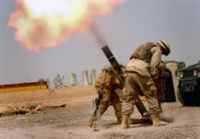Articles >>
Mortar
Category: Term of the day

A mortar is a muzzle-loading indirect fire weapon that fires shells at low velocities, short ranges, and high-arcing ballistic trajectories. It typically has a barrel length less than 15 times its caliber. A mortar is relatively simple and easy to operate. A modern mortar consists of a tube which gunners drop a shell into. A firing pin at the base of the tube detonates the propellant and fires the shell. These attributes contrast with the mortar's larger siblings, howitzers and field guns, which fire at higher velocities, longer ranges, flatter arcs, and sometimes, direct fire. In the 19th and early 20th centuries very heavy immobile siege mortars were used, of up to one metre calibre. A mortar can also be a launcher for fireworks, a hand-held or vehicle-mounted projector for smoke shells or flares, or a large grenade launcher. Light and medium mortars are portable, and usually used by infantry units. The chief advantage a mortar section has over an artillery battery is its small numbers, mobility and the ability to engage targets in the defilade with plunging fires. It is able to fire from the protection of a trench or defilade. In these aspects the mortar is an excellent infantry support weapon, as it can be transported over any terrain and is not burdened by the logistical support needed for artillery. There are also heavy mortars of 120mm to 300mm caliber. These weapons are usually towed or vehicle-mounted, sometimes breech-loaded, and normally employed by infantry units attached to battalion through division level. Even at this size, mortars are simpler and less expensive than comparable howitzers or field guns. A mortar can be carried by one or more men (larger mortars can usually be broken down into components), or transported in a vehicle. An infantry mortar can usually also be mounted and fired from a mortar-carrier, a purpose-built or modified armoured vehicle with a large roof hatch. A heavy mortar can be mounted on a towed carriage, or permanently vehicle-mounted as a self-propelled mortar. Twin-barreled self-loading mortars — such as the Patria AMOS PT1 — are the latest evolution of these heavy mortars and are mounted on platforms such as armored personnel carriers, tank chassis, and coastal patrol boats. Most modern mortar systems consist of three main components: a barrel, a base plate, and a bipod. Modern mortars normally range in calibre from 60mm (2.36 inches) to 120mm (4.72 inches). However, mortars both larger and smaller than these specifications have been produced. An example of the smaller scale is the British 51mm light mortar which is carried by an individual and consists of only a tube and a base plate. Conversely, a large example is the Soviet 2S4 M1975 "Tyulpan" (tulip tree) 240mm self-propelled mortar. Smaller mortars (up to 81mm) are commonly used and transported by infantry based mortar sections as a substitute for, or in addition to, artillery. Ammunition for mortars generally come in two main varieties: fin-stabilised and spin-stabilised. The former have short fins on their posterior portion which control the path of the shell in flight. Spin-stabilized mortars rotate as they travel along and leave the mortar tube. This action stabilizes them in much the same way that a rifle bullet is, or that the American football) is stabilized when thrown in a "spiral." Both types of rounds can be either illumination (infrared or visible illumination), smoke, or high explosive. Spin-stabilised rounds require a rifled barrel. Since mortars generally are muzzle loaded, the mortar shell has a pre-engraved band, called an obturator, that engages with the rifling of the barrel. The increase in accuracy is at a cost in loading time and having to account for drift, a peculiarity of rifled systems that causes the round to "drift" perpendicular to the spin axis; this Magnus effect is common to any spinning projectile, and is, for example, what makes it possible for pitchers to throw curve balls. Mortars come in a variety of calibres. The French 81mm mortar became standard for many countries. The Soviets took tactical advantage of this. They standardised an 82mm mortar for their armies. Hence, troops using Soviet mortars could use mortar ammunition of other countries found on the battlefield, albeit with less accuracy, while their own would be too large for their opponents. This advantage was used during the Vietnam War and at other times. |
BAE Systems` CV90 increases lethality by testing SPIKE LR anti-tank guided missile
14.01.2020
Otokar offers solutions with technology transfer and local manufacturing models
13.09.2019
Supacat, Rheinmetall and SCISYS partnership showcases new High Mobility Integrated Fires Capability
12.09.2019
Dragon Fire/Box Mortar (Self-propelled mortar)
Discuss
